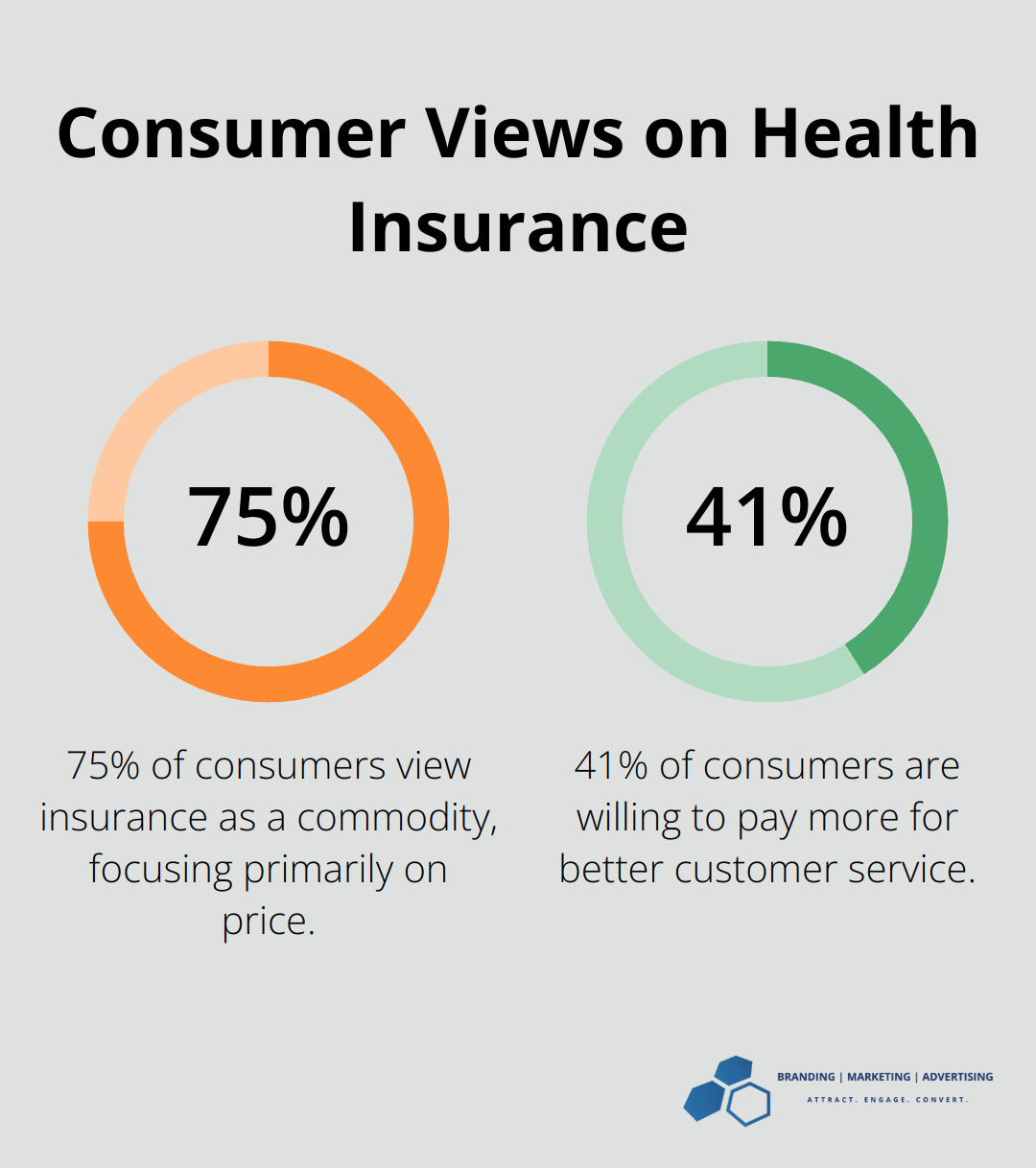How to Boost Your Health Insurance Marketing Strategy
Health insurance marketing ideas are evolving rapidly in today’s digital landscape. At Branding | Marketing | Advertising, we’ve seen firsthand how effective strategies can significantly impact a company’s success in this competitive industry.
Our blog post will guide you through proven techniques to enhance your health insurance marketing approach. From understanding your target audience to leveraging digital channels, we’ll explore practical ways to boost your marketing efforts and drive results.
Who Are Your Health Insurance Customers
Understanding your target audience forms the foundation of any successful health insurance marketing strategy. We at Branding | Marketing | Advertising have witnessed how a deep understanding of customer demographics, behaviors, and preferences transforms marketing efforts.
Pinpointing Your Key Demographics
Health insurance needs vary widely across different age groups and life stages. Young professionals often prioritize low-cost plans with basic coverage, while families typically seek comprehensive packages that include pediatric care. Seniors usually look for plans with extensive prescription drug coverage and specialized care options.
We recommend segmenting your audience based on age, income, occupation, and family status. A study by the Kaiser Family Foundation found that 31% of adults aged 19-64 were underinsured in 2020. This statistic highlights a significant market opportunity for tailored plans targeting this age group.
Decoding Consumer Behavior
Consumer behavior in the health insurance market is complex and often driven by personal experiences and perceived value. A survey by Accenture revealed that 75% of consumers view insurance as a commodity, focusing primarily on price. However, 41% are willing to pay more for better customer service.

To tap into these insights, we suggest conducting regular surveys and focus groups with your existing customers. This approach helps identify pain points and preferences that can inform your product development and marketing strategies.
Harnessing the Power of Data Analytics
Data analytics is a game-changer in understanding and predicting customer behavior. Analyzing customer interactions, claims history, and online behavior allows you to create highly targeted marketing campaigns.
For example, a regional health insurer implemented a data-driven marketing strategy that increased their retention by 5 to 10 percent within profitable segments. The key was using predictive analytics to identify customers at risk of churning and proactively addressing their concerns.
Personalizing Your Approach
Once you’ve gathered and analyzed your data, the next step is personalization. According to a study by Epsilon, 80% of consumers are more likely to make a purchase when brands offer personalized experiences.
We recommend creating detailed customer personas based on your data insights. These personas should guide everything from your product offerings to your marketing messages. For instance, a persona for a health-conscious millennial might lead to marketing campaigns focused on preventive care and wellness programs.
Leveraging Social Listening
Social media platforms are goldmines of customer insights. Monitoring social media conversations about health insurance can provide real-time insights into customer concerns and preferences.
Tools like Sprout Social or Hootsuite can help you track mentions of your brand and industry-related keywords. This information can inform your content strategy and help you address customer concerns proactively.
As we move forward, it’s essential to consider how these insights can shape your content creation strategy. In the next section, we’ll explore effective ways to craft compelling health insurance content that resonates with your target audience.
How to Create Compelling Health Insurance Content
At Branding | Marketing | Advertising, we understand the importance of creating compelling health insurance content to engage potential customers and build trust. Here’s how you can craft content that resonates with your audience and drives results.
Simplify Complex Information
Health insurance often confuses consumers. Our approach breaks down complex topics into easily digestible pieces. For example, a series of short videos explaining common insurance terms like “deductible” and “copay” saw a 40% higher engagement rate compared to traditional text-based explanations.
Develop a glossary of insurance terms on your website. This resource serves as a valuable reference for customers and improves your site’s SEO. According to the World Health Organization, health literacy skills are crucial for managing health and preventing disease. Clear, simple explanations not only market your services but also educate and empower your audience.
Tell Real Stories
Real-life experiences resonate powerfully. Sharing customer testimonials and case studies significantly increases engagement and trust.
Create a “Customer Stories” section on your website. Feature diverse stories that highlight different aspects of your insurance offerings. (Remember to get proper permissions and follow HIPAA guidelines when sharing any personal health information.)
Leverage Visual Content
The human brain processes visual content 60,000 times faster than text. Infographics that illustrate complex health insurance concepts have proven highly successful. An infographic comparing different types of health plans received 300% more shares on social media compared to a text-based article on the same topic.

Invest in high-quality graphics and videos. Use these to explain insurance concepts, showcase benefits, or provide health tips. (Tools like Canva or Piktochart can help create professional-looking visuals even without a design background.)
Focus on Prevention and Wellness
Health insurance promotes wellness, not just covers illness. Content focused on preventive care and healthy living resonates well with audiences. A blog series on “5-Minute Health Habits” saw a 50% higher engagement rate compared to posts about insurance policies.
Create a wellness blog or newsletter. Share tips on nutrition, exercise, mental health, and preventive screenings. This type of content positions your brand as a partner in health, not just an insurance provider.
The key to compelling health insurance content lies in focusing on the human aspect. Whether you explain a complex policy or share wellness tips, always tie it back to how it benefits the customer’s life and health. This approach creates content that not only informs but also engages and converts.
As we move forward, let’s explore how to effectively leverage digital marketing channels to maximize the reach and impact of your compelling health insurance content.
How Digital Channels Boost Your Health Insurance Marketing
Digital platforms play a vital role in effective health insurance marketing today. Let’s explore practical strategies to maximize your digital marketing efforts.
Optimize Your Website for Search Engines
Your website often serves as the first point of contact for potential customers. To improve your ranking:
- Conduct keyword research focusing on terms like “affordable health insurance” or “family health plans.”
- Optimize your page titles, meta descriptions, and headers with these keywords.
- Create high-quality, informative content that answers common health insurance questions.
- Improve your site’s loading speed – this can help you rank higher on Google and make more sales.
Make your website mobile-friendly. Mobile apps can streamline customer experience for health insurance enrollments.
Harness the Power of Social Media
Social media platforms offer unique opportunities to connect with your audience. A report by Sprout Social shows that 57% of consumers follow a brand’s social page to learn about new products or services. Here’s how to make the most of social media:
- Choose platforms where your target audience is most active. (LinkedIn might be ideal for B2B health insurance marketing, while Facebook could be better for reaching families.)
- Share educational content about health insurance, wellness tips, and industry news.
- Use visuals like infographics or short videos to explain complex insurance concepts.
- Engage with your followers by responding to comments and messages promptly.
Personalize Your Email Marketing
Email remains a powerful tool for nurturing leads and retaining customers. According to Campaign Monitor, email marketing has an ROI of 4400%. To make your email marketing more effective:

- Segment your email list based on factors like age, family status, or previous interactions.
- Personalize your emails beyond just using the recipient’s name. Tailor the content to their specific needs or interests.
- Use automation to send timely, relevant emails. (For example, send a reminder email when it’s time for a customer to renew their policy.)
- A/B test your email subject lines, content, and call-to-actions to continually improve performance.
Leverage Content Marketing
Content marketing can position your brand as a trusted authority in health insurance. HubSpot reports that businesses using blogs get 67% more leads than those that don’t. Here’s how to create impactful content:
- Develop a content calendar focusing on topics relevant to your audience, such as understanding health insurance terms or tips for choosing the right plan.
- Create diverse content types including blog posts, videos, podcasts, and infographics.
- Optimize your content for SEO to improve visibility in search results.
- Promote your content across various channels including social media and email newsletters.
Utilize Pay-Per-Click Advertising
Pay-Per-Click (PPC) advertising can drive targeted traffic to your website. Google reports that businesses make an average of $2 in revenue for every $1 they spend on Google Ads. To maximize your PPC efforts:
- Choose keywords carefully, focusing on terms with high intent like “buy health insurance” or “compare health plans.”
- Create landing pages specifically for your PPC campaigns to improve conversion rates.
- Use ad extensions to provide additional information like your phone number or links to specific pages on your site.
- Regularly review and adjust your campaigns based on performance data.
These strategies can significantly enhance your digital marketing efforts. The key is to provide value to your audience at every touchpoint. Whether it’s through informative content, personalized emails, or targeted ads, focus on addressing your customers’ needs and concerns.
Final Thoughts
Effective health insurance marketing requires a multifaceted approach. Companies must understand their target audience, create compelling content, and strategically use digital channels. These health insurance marketing ideas can significantly enhance marketing efforts and drive better results.
The health insurance landscape constantly evolves. Companies should stay informed about industry trends, regulatory changes, and technological advancements. They must adapt their marketing strategies based on performance data and customer feedback to achieve sustainable growth.
At Branding | Marketing | Advertising, we help businesses implement effective digital marketing strategies. Our team of experts can guide you through the process of enhancing your health insurance marketing efforts (ensuring you reach the right audience with the right message at the right time).












